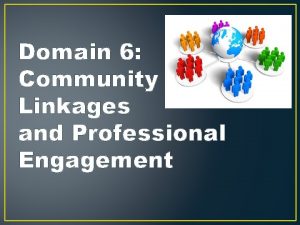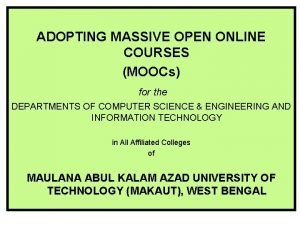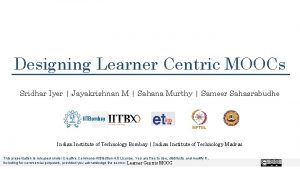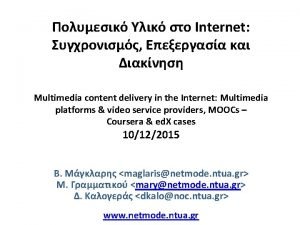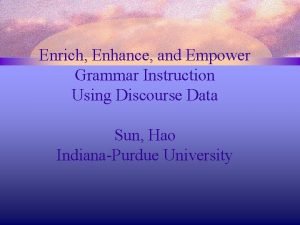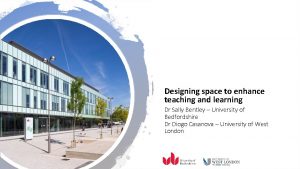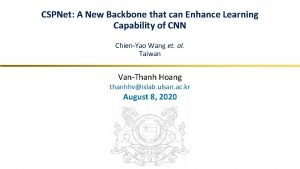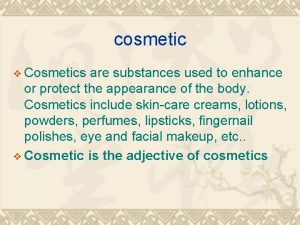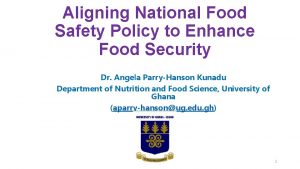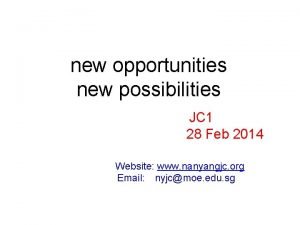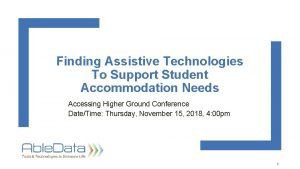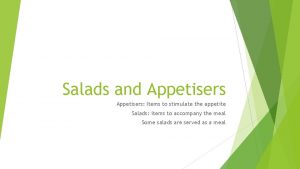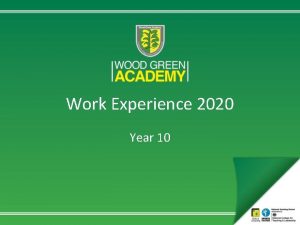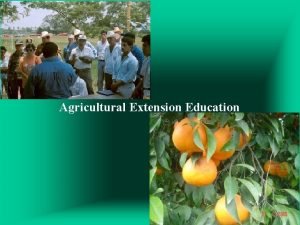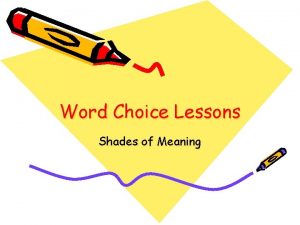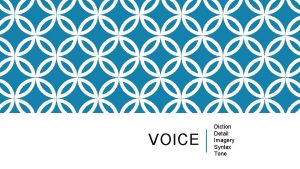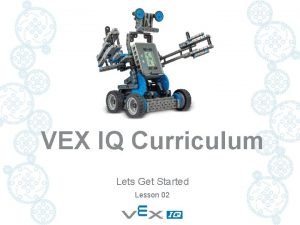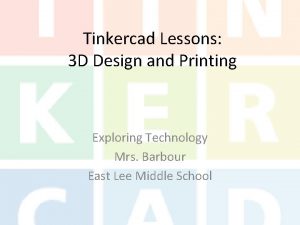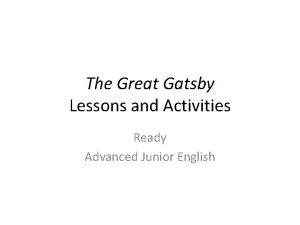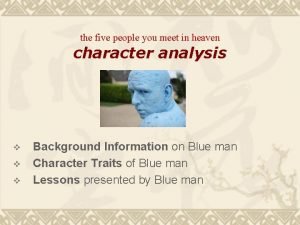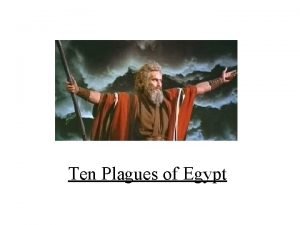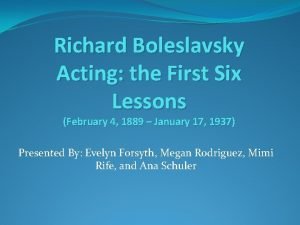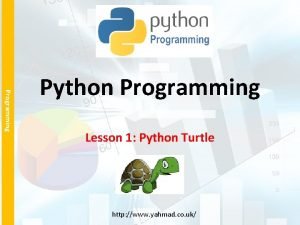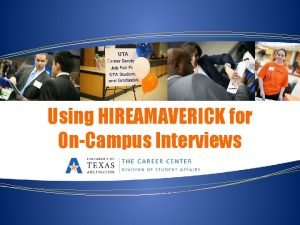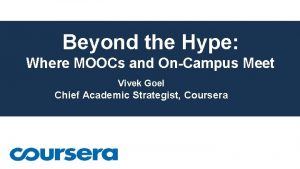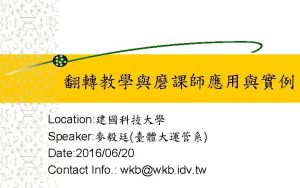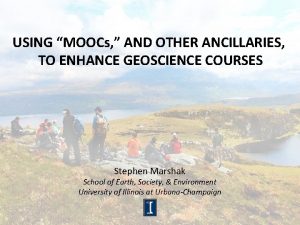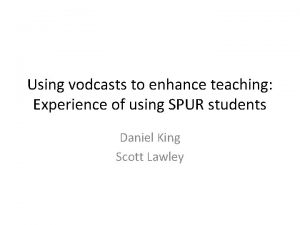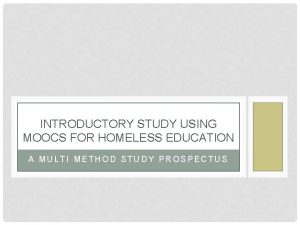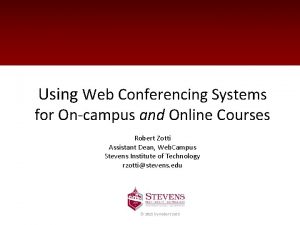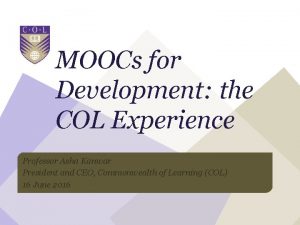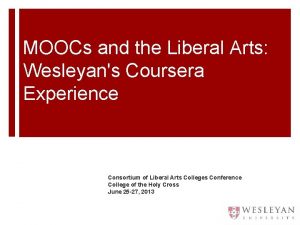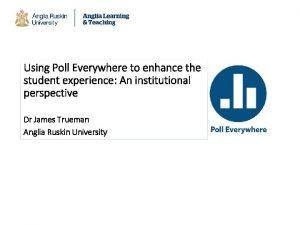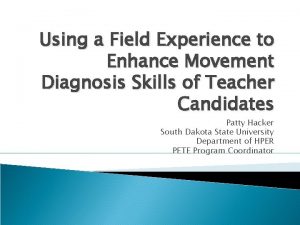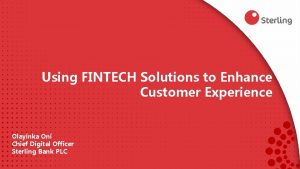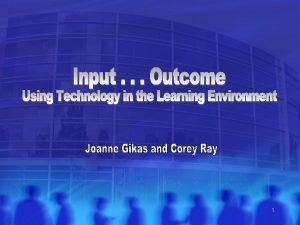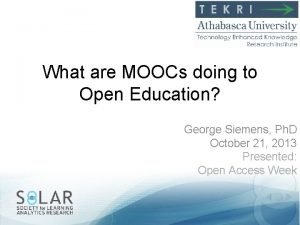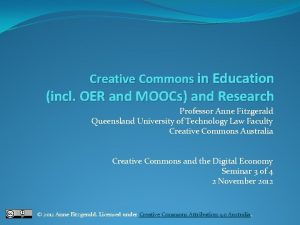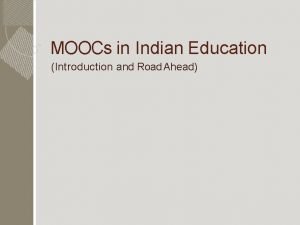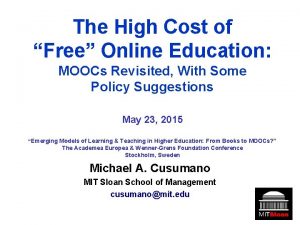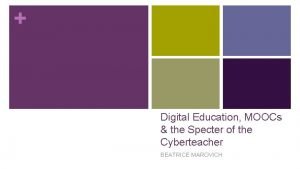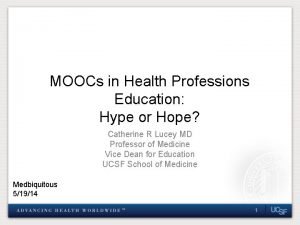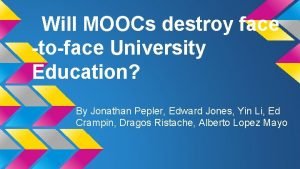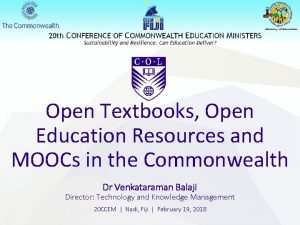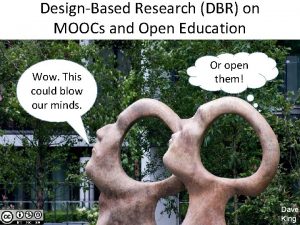Using MOOCs to enhance oncampus education Experience lessons

































- Slides: 33

Using MOOCs to enhance on-campus education Experience, lessons, and research opportunities Douglas H. Fisher Director of the Vanderbilt Institute for Digital Learning Associate Professor of Computer Science and of Computer Engineering Vanderbilt University Nashville, TN Presentation to No way back? Exploring the impact, data and potential of MOOCs Sponsored by Association for Learning Technology Wednesday, November 6, 2013

Douglas H. Fisher Learning: Engage and Empower Infrastructure: Access and Enable Teaching: Prepare and Connect Assessment: Measure What Matters Productivity: Redesign and Transform

A Grand Challenge: Personalized Education Learning: Engage and Empower “The model of learning described in this plan calls for engaging and empowering learning experiences for all learners. The model asks that we focus what and how we teach to match what people need to know, how they learn, where and when they will learn, and who needs to learn. It brings state-of-the art technology into learning to enable, motivate, and inspire all students, regardless of background, languages, or disabilities, to achieve. It leverages the power of technology to provide personalized learning and to enable continuous and lifelong learning. ” National Education Technology Plan 2010, Executive Summary U. S. Department of Education, Office of Educational Technology, p. 10 Douglas H. Fisher

http: //www. youtube. com/watch? v=dqa. DSl. Yd. Rcs Douglas H. Fisher

http: //www. cccblog. org/2011/11/22/more-stanford-cs-entrepreneurship-courses-go-online/ Vanderbilt Fall 2011 Douglas H. Fisher

https: //my. vanderbilt. edu/cs 265/ An example in Database class Flipping the class: “Passive” info reception out of class; active learning in class Douglas H. Fisher Video lectures from a Stanford MOOC

https: //class. coursera. org/db/lecture/3 Douglas H. Fisher

https: //my. vanderbilt. edu/cs 265/ In Class Exercises Example in-class session In Database class, 'flipping’ enabled small-group problem solving and/or treatment of larger scale database designs that illustrated the concepts. 1. Watch the Hans Rosling video on visualizing data at http: //www. youtube. com/watch? v=jbk. SRLYSojo (a 4 minute video) 2. Dr. Rosling concludes that the analysis involved plotting “ 120, 000 numbers. ” Explain where the 120, 000 count came from. 4. Give candidate (tentative) relational schema (at least two) for a database that would support this and similar analyses 5. Give three queries in relational algebra over the schema that you give in part 4, which you think would be useful for the video’s analysis or a similar analysis Douglas H. Fisher 3. List the attributes that you believe must be stored in a database that supports this analysis (and perhaps similar analyses)

Douglas H. Fisher

Brief history with (other professors’) MOOCs Since Spring 2012: Have used online lectures by others for • Database (Spring 2012, Spring 2013) • Machine Learning (Spring 2012, Fall 2012) Summary of all use • Artificial Intelligence (Fall 2012) With following instructor and course ratings on 5 point scale ; 3 is “average” • Database (S 13) Instructor Average: 4. 41 (0. 69) Course Average: 4. 24 (0. 72) Database (S 12) Instructor Average: 4. 27 (0. 74) Course Average: 3. 63 (0. 64) pre-MOOC use: 4. 00 (0. 95) from Spring 2011 3. 41 (1. 11) • Machine Learning (F 12) Instructor Average: 4. 16 (0. 68) Course Average: 4. 16 (0. 68) Machine Learning (S 12) Instructor Average: 4. 33 (0. 66) Course Average: 4. 22 (0. 41) pre-MOOC use: 3. 83 (0. 89) from Spring 2006 3. 66 (1. 11) • AI (F 12) Instructor Average: 4. 25 (0. 66) Course Average: 4. 00 (0. 70) pre-MOOC use: 4. 25 (1. 03) from Fall 2011 4. 05 (0. 72) Summary Observation: Instructor rating and course rating means went up or held steady; standard deviations went down; but beware confounds! Douglas H. Fisher

Video call out(s) from an AI MOOC in Fall 2012 of MY video http: //www. youtube. com/channel/UCWOFdp. Ef. Nu. QP 3 O_JUiwh. T 8 A Number of Views, top-8 videos 6, 353 biggest ‘hit’ 4, 657 4, 533 1, 662 1, 557 1, 471 1, 007 my first ‘hit’ 37, 262 views total since Fall 2012 119 thumbs up, 3 thumbs down; 73 subscribers Douglas H. Fisher

Why this pattern? (hypothesis – because of MOOCs)

A course that feels like a collaborative effort Douglas H. Fisher

Students and faculty can crowd-source textbook creation (here, an example of a lab text by “the community”) Douglas H. Fisher Artificial Intelligence for Computational Sustainability: A Lab Companion http: //en. wikibooks. org/wiki/Artificial_Intelligence_for_Computational_Sustainability: _A_Lab_Companion

Next step (I hope): use nb to enable online annotation. Reinvigorate textbooks by making them environments/contexts for discourse Douglas H. Fisher My video lectures have used slides, licensed for derivations, from course textbook site nb is an annotation taking tool developed by the Haystack Group at CSAIL. Students and Faculty can use nb to annotate arbitrary PDF files online, in a collaborative fashion. nb. mit. edu/about/

Creative programing For digital media & Mobile Apps (U of London) Web Intelligence and Big Data (IIT, Dehli) The next Machine Learning course I teach will be drawn from multiple sources, including some of my own Software Defined Networks (U Maryland) Malicious Software underground story (U of London) Functional Programming Principles in Scala (Ecole Polytechnique) Heterogeneous Parallel Programming (Stanford) Interactive Programming community Crytography (Rice) Machine Learning (Stanford) Gamification (Stanford) Applied (U Penn) Machine Learning Crytography (U Washington) AI Planning (Udacity) (Edinburgh) Discrete Computing for customization Optimization NLP Data Analysis (Melbourne) (Stanford) (Johns Hopkins) Networked Life (U Penn) Social Network Analysis (Michigan) Image and Video (Duke) Computational Photography (Ga. Tech) Computer Vision (UC Berkeley) Computer Vision (Stanford/Michigan) VLSI CAD: Logic to Layout (UIUC) Coding the Matrix: Linear Algebra CS applications (Brown) Douglas H. Fisher Creative, Serious and Playful Science of Android Apps (UIUC)

Some questions suggested from this experience Educational Data Mining look beyond individual MOOCs, and mine data in a MOOC’s “solar system” and beyond look for correlations between MOOC activity and other online content (e. g. , Youtube, Wikipedia) intentional content creation (e. g. , on Youtube) to fill MOOC gaps Other tracking of community growth Benefits (or not) of MOOCs for on-campus education flipping the classroom; course design issues in wrapping a MOOC faculty engagement Local learning communities within global learning communities “the world is flat” – Thomas Friedman Douglas H. Fisher

Customization and Crowdsourcing Micro-construct customization Lessons and courses Macro-construct customization Curricula Douglas H. Fisher

Online Computer Science curricula can be customized from courses that are free and online (this slide, some “Basic” courses) Introduction to Logic (Stanford) Learn to Program: Fundamentals (Toronto) “equivalent” alternatives Combinatorics (Princeton) Introduction to Computer Science 1 (Harvard) and 2 (MIT) Learn to Program: Crafting Quality Code (Toronto) CS 101 Introduction to Computer Science (Udacity) CS 212 Design of Computer Programs (Udacity) October 2012 Computer Science 101 (Stanford) “equivalent” alternatives The Hardware/Software Interface (U Washington) CS 215 Algorithms Part 1 Algorithms: (Princeton) Crunching Social Networks “equivalent” (Udacity) alternatives Algorithms: Design and Analysis, Part 1 (Stanford) Douglas H. Fisher

A plethora of resources enable customized curricula Introduction to Logic (Stanford) Learn to Program: Fundamentals (Toronto, Coursera) “equivalent” alternatives Combinatorics (Princeton) Introduction to Computer Science 1 (Harvard) and 2 (MIT) Learn to Program: Crafting Quality Code (Toronto) CS 101 Introduction to Computer Science (Udacity) CS 212 Design of Computer Programs (Udacity) October 2012 Computer Science 101 (Stanford) “equivalent” alternatives The Hardware/Software Interface (U Washington, Coursera) CS 215 Algorithms Part 1 Algorithms: (Princeton) Crunching Social Networks “equivalent” (Udacity) alternatives Algorithms: Design and Analysis, Part 1 (Stanford, Coursera) Douglas H. Fisher

Opportunities • Nascent steps towards crowd-sourced curricula Douglas H. Fisher

POSA Heat Map But local learning communities too https: //www. coursera. org/course/posa 2 Adapted from Doug Schmidt

https: //www. coursera. org/course/onlinegames first 15 minutes Douglas H. Fisher

http: //commonplace. vanderbilt. edu/? i=6856 A recurring theme: local learning communities embedded in global learning community Douglas H. Fisher

Opportunities • Local learning communities embedded in global community … faculty and alums modeling lifelong learning 10 s of 1000 s of students Worldwide, 20 faculty, staff, students, alums, and two OSHER students at Vanderbilt Douglas H. Fisher

Design Strategies for MOOCs • Design MOOCs with local learning communities in mind, so that the designs of MOOCs and of local learning “architectures” co-evolve, • rather than simply relying on opportunistic, as-is use; to a great extent this is a lesson from the larger, pre-MOOC experience with online and blended learning • Design MOOCs explicitly for course customization, with material intended to be reused, remixed, and revised (this seems a very novel suggestion). • Even those aspects of MOOCs that are consistent with remixing (e. g. , short videos), are done for other reasons (e. g. , student attention span), rather than with customization in mind per se • Design MOOCs with research opportunities in mind, in areas such as educational data mining and human-computer interactions (though we are seeing more of this), • Rather than simply opportunistic, after-the-fact hypothesis generation Douglas H. Fisher

Strengths • Disruption: undergraduate education in the national spotlight • Disruption: made scales of openness and size explicit • Changing Faculty Roles: active learning (flipping the class) • Faculty must “up their game” (on the education side) • Access to Higher Education (for those formally without) • Branding and recruitment (for institutions and individuals) • Proliferation of Online Content creation and sharing by faculty and students • Learning about learning educational data mining (which started before MOOCs) Douglas H. Fisher

Weaknesses • High costs (time and money) to start up • Non-uniform student population (prerequisite satisfaction) • Many students isolated (apropos “drop-out” rates) Douglas H. Fisher

Processes and Costs • Start-up costs, including studios (10 s of $1000 s) • Course design (Cf. T) and pre-production reviewing for quality, copyright (library), cultural sensitivities • Production Monetary Costs (faculty release, supplements) Iteration with course design • Post Course assessment and revision and reoffering “A general filmmaking rule I learned at Vandy, and have experienced in my own work, is that every minute of final video will require, at bare minimum, one hour of editing; i. e. a 10 -minute video will take at least 10 hours to edit. I'd say that combining my and <the instructor’s> effort on these videos will yield at least 300 hours of work” One of our dedicated videographers Douglas H. Fisher • Offering Instructor involvement, TAs, real-time revision of material

Opportunities • Engaging alums, as lifelong learners, TAs, mentors, and instructors Non-uniform population not all bad, if planned for • Recruiting help (TAs, tutors) through the online population ( http: //cloudandcampus. blogspot. com/2013/05/finding-best-teaching-assistant-in-world. html ) • Continuous improvement (using global population for feedback) • Students can cheaply sample new subjects • Across-institution created MOOCs (e. g. , on Sustainability) • Local learning communities (e. g. , on campus courses) embedded in global community students directly benefitting from feedback student awareness of cultural differences student awareness of global competitiveness faculty and alums modeling lifelong learning Douglas H. Fisher

Opportunities • Will computing technologies and educational expertise combined to promote personalized learning at scale, allow assessments (e. g. , ABET), both “pre-visit” and “visit”, to be done “automatically”, while still • thoroughly • consistently • efficiently in say, 10 -20 years? Technology will beg data collection and (perhaps) a deep infusion of Assessment! (e. g. , see Vanderbilt’s Knowledge Map: http: //knowledgemap. mc. vanderbilt. edu/research/content/knowledgemap-km-web-application • Generally, increasing bang for the buck can involve • reducing the buck, which is way above my pay-grade and currently very controversial • increasing the bang (e. g. , MOOCs for lifelong and life-wide learning, involving campus students in global discourse), and often at my discretion (e. g. , MOOCS to satisfy course prerequisites) Douglas H. Fisher

Threats • Changing faculty roles: educational “factories” • Quality control (poor quality broadcast to the World) • Conflicts of commitment (unbundled universities) • Cheating • The demise of textbooks (but see text annotation tools) • Intellectual property Douglas H. Fisher

List of Courses that used MOOC material https: //my. vanderbilt. edu/cs 260/ Undergraduate AI … used lecture material from Web, including my own https: //my. vanderbilt. edu/cs 360 fall 2012/ Graduate AI … no MOOC material per se, but students required to produce a video lecture on undergraduate AI content of a Tutorial nature https: //my. vanderbilt. edu/cs 390 fall 2012/ Graduate Machine Learning course, true wrapper, requiring satisfaction of COURSERA/Stanford MOOC course and additional reading and project https: //my. vanderbilt. edu/cs 265/ Undergraduate Database, using COURSERA/Stanford Lectures (required in S 12, now optional, waiting to see how user agreements settle out) Other Links You. Tube channel of my online content: https: //www. youtube. com/channel/UCWOFdp. Ef. Nu. QP 3 O_JUiwh. T 8 A? feature=mhee Workshop on Multidisciplinary Research for Online Education: http: //www. cra. org/ccc/visioning-activities/online-education/286 -multidisciplinary-research-foronline-education-workshop Bruff, D. , Fisher, D. , Mc. Ewen, K. , & Smith, B. (in press) “Wrapping a MOOC: student perceptions of an experiment in blended learning. ” Journal of Online Learning and Teaching. https: //my. vanderbilt. edu/douglasfisher/files/2013/06/JOLTPaper. Final 6 -9 -2013. pdf Learning on Campus and in the Cloud blog: http: //cloudandcampus. blogspot. com/ Douglas H. Fisher A narrative summary of my experience “Warming up to MOOCs” http: //chronicle. com/blogs/profhacker/warming-up-to-moocs/44022
 Ppst domain 6
Ppst domain 6 Moocs makaut
Moocs makaut Iit bombay x
Iit bombay x Designing learner-centric moocs
Designing learner-centric moocs Moocs
Moocs Imprint definition psychology
Imprint definition psychology Early experience vs. later experience
Early experience vs. later experience Example of indirect experience
Example of indirect experience Grammar to enrich and enhance writing
Grammar to enrich and enhance writing Fashion cycle
Fashion cycle Enhance an image
Enhance an image Cspnet
Cspnet Cosmetics are substances that are used to enhance
Cosmetics are substances that are used to enhance Enhance an image
Enhance an image Nanyang jc subject combination
Nanyang jc subject combination Enhance life
Enhance life A salad that stimulates appetite
A salad that stimulates appetite Can hypnosis enhance recall of forgotten events
Can hypnosis enhance recall of forgotten events Sips education work experience
Sips education work experience System.collections.generics
System.collections.generics Dtfd switch
Dtfd switch Venn diagram formal education and nonformal education
Venn diagram formal education and nonformal education Difference between health education and health promotion
Difference between health education and health promotion Backbone of extension education
Backbone of extension education Word choice lessons
Word choice lessons 5 elements of voice
5 elements of voice Vex iq lessons
Vex iq lessons Tinkercad lessons for middle school
Tinkercad lessons for middle school The shunammite woman lessons
The shunammite woman lessons Great gatsby lesson
Great gatsby lesson The five people you meet in heaven lessons
The five people you meet in heaven lessons 7 plagues of egypt
7 plagues of egypt Acting the first 6 lessons
Acting the first 6 lessons Python turtle lessons
Python turtle lessons
